The Toshiba TR200 3D NAND SSD Review: One Step Forward, One Step Back
by Billy Tallis on October 11, 2017 7:00 AM ESTMixed Random Performance
Our test of mixed random reads and writes covers mixes varying from pure reads to pure writes at 10% increments. Each mix is tested for up to 1 minute or 32GB of data transferred. The test is conducted with a queue depth of 4, and is limited to a 64GB span of the drive. In between each mix, the drive is given idle time of up to one minute so that the overall duty cycle is 50%.

The mixed random I/O performance of the Toshiba TR200 is much faster than the HP S700, but is slower than everything else, even the earlier Trion/TR series drives. Contemporary budget SSDs like the ADATA SU800 and Crucial MX300 are more than twice as fast.
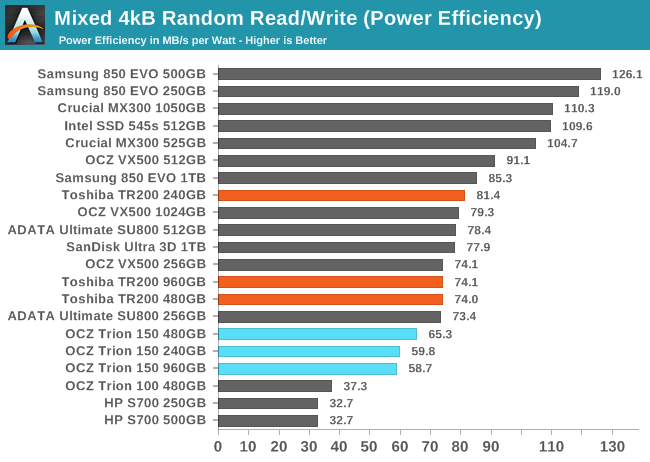
The power efficiency of the TR200 during the mixed random I/O test is a marked improvement over the TR150 and is more than twice that of the HP S700, but that's not enough for the TR200 to rate much better than acceptable.
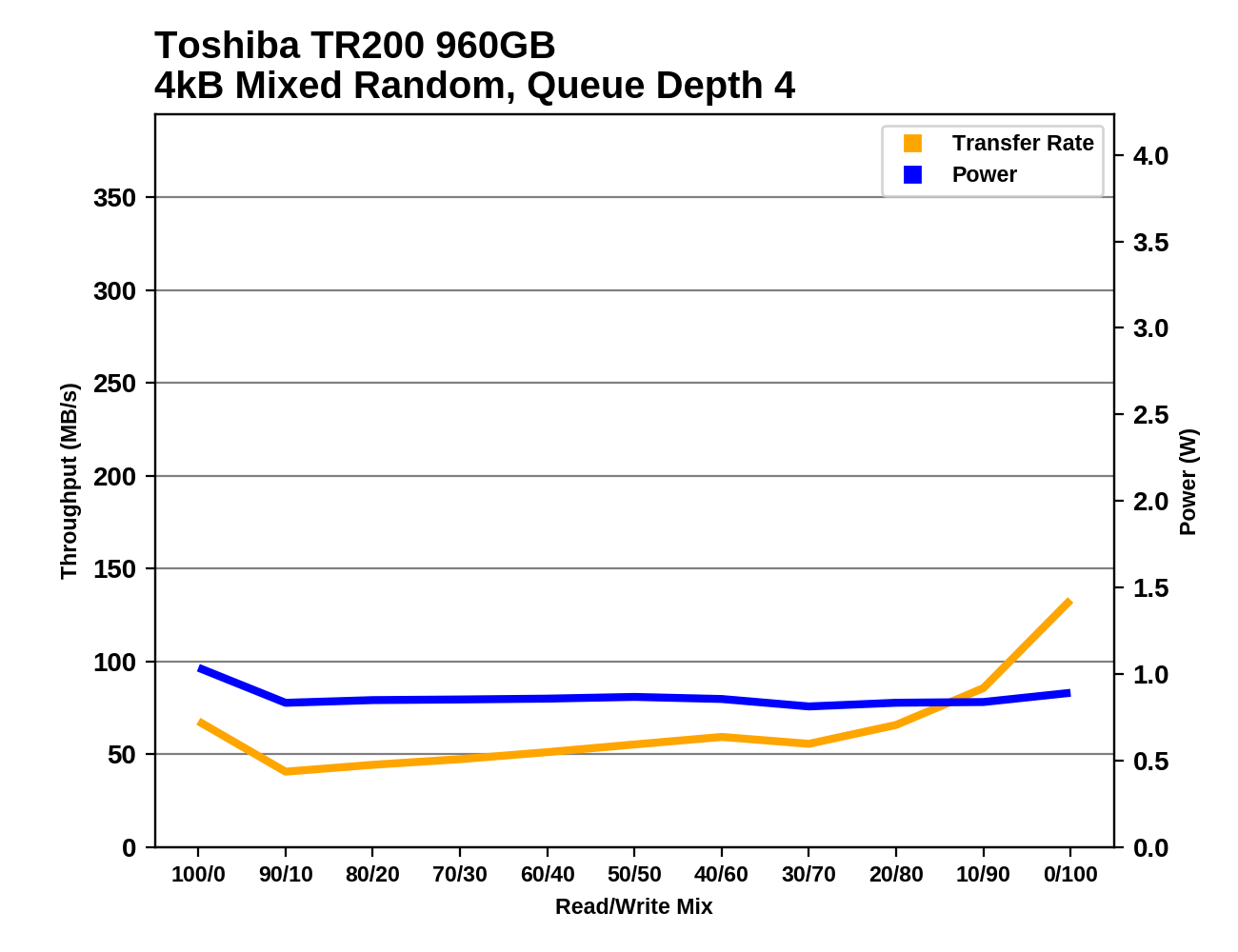 |
|||||||||
The performance of the TR200 during the mixed random I/O test traces out a common bathtub curve shape, with performance dropping after the initial pure reads phase and climbing very slowly as the proportion of writes increases, before accelerating near the end of the test as the workload shifts to mostly writes. The TR200s don't show a large spike in performance at the very end of the test like the TR150 does, but at least they don't bottom out anywhere near as low as the HP S700.
Mixed Sequential Performance
Our test of mixed sequential reads and writes differs from the mixed random I/O test by performing 128kB sequential accesses rather than 4kB accesses at random locations, and the sequential test is conducted at queue depth 1. The range of mixes tested is the same, and the timing and limits on data transfers are also the same as above.
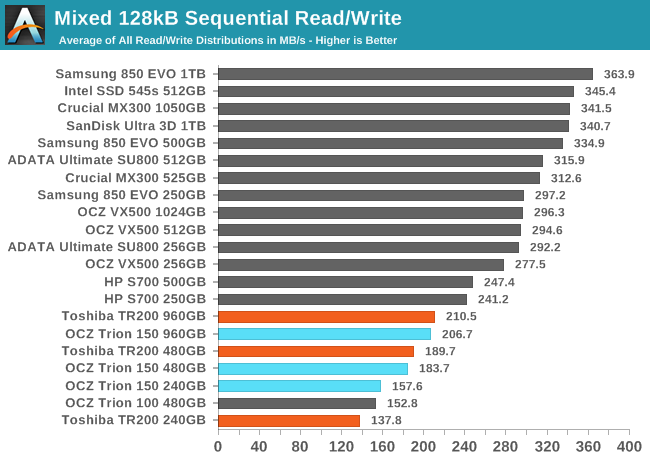
The larger two Toshiba TR200 models are marginally faster than their TR150 predecessors on the mixed sequential I/O test, but the 240GB has lost more than 12% of its overall performance. All of the TR/Trion series drives remain at the bottom of the chart, well below even the other DRAMless SSDs.
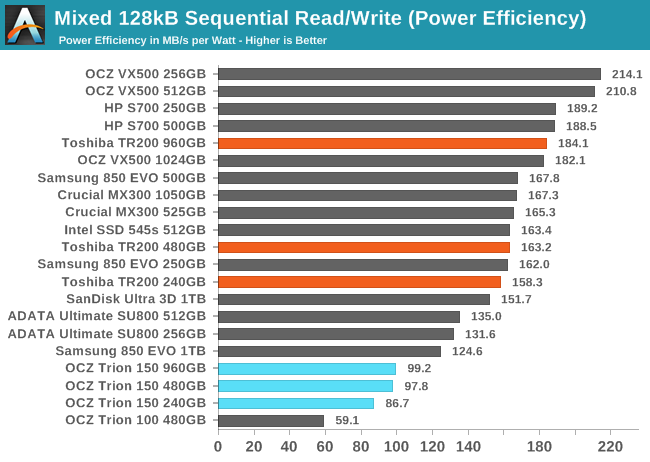
The TR200 climbs out of last place for power efficiency, and the 960GB model in particular is near the top of the chart along with the other DRAMless SSDs. The smaller two capacities have fairly average efficiency.
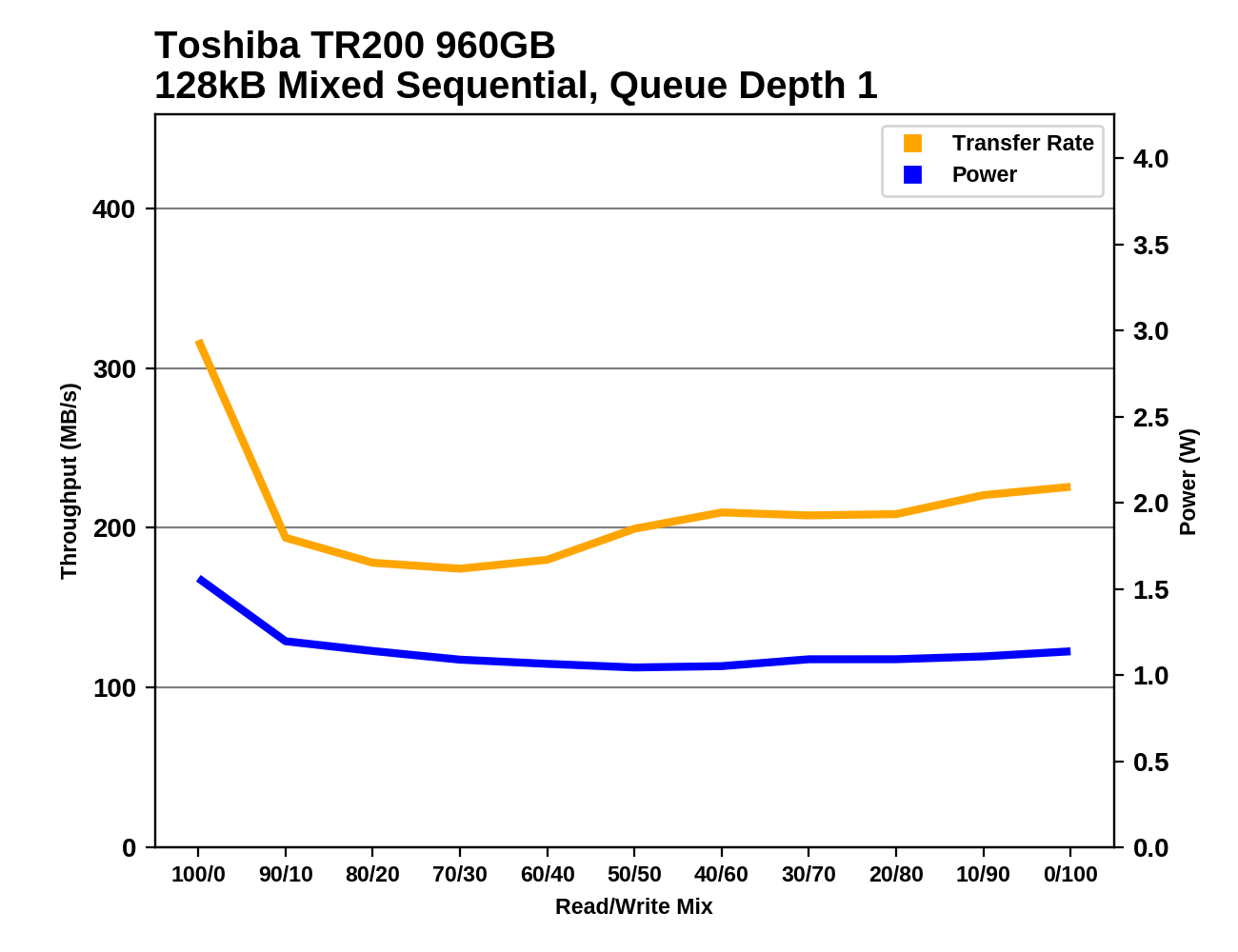 |
|||||||||
All three of the TR200 models lose a lot of performance when writes are first added to the workload, but they regain a bit of performance through the first half of the test. The 960GB model gains a bit more performance in the second half of the test while the smaller models drop off again. The drives that do well on this test mostly either regain significant performance in the second half, or show steady increases across the entire test.










50 Comments
View All Comments
r3loaded - Wednesday, October 11, 2017 - link
Pwned by an 850 Evo but only $10 cheaper. Yay what a surprise.ddriver - Wednesday, October 11, 2017 - link
Cudos to toshiba for making an ssd that is as slow in sequential writes as a mechanical hdd. I can't imagine it was easy.It's a serious contender for "lousiest sata ssd of 2017".
masouth - Wednesday, October 11, 2017 - link
of just 2017?takeshi7 - Wednesday, October 11, 2017 - link
correction: slower than an hdd in sequential writes. But then again a lot of these cheap TLC drives have lower sustained write speed than HDDs. What really amazes me is that Toshiba actually made an SSD that's worse than the Crucial BX200. I never thought that would be possible.Samus - Wednesday, October 11, 2017 - link
At 1/10th the power consumption though. As hard as it is to defend this drive, it’s clear toshiba had a very specific goal in mind with this drive: cheap upgrades for cheap laptops. As an OEM supplier for many vendors (including even Apple) this drive is adequate for many sub-$500 laptops: being dramless makes power loss protection mostly unnecessary as it will likely recover from sram loss inside the controller, as the indirection table is mirrored off then back to the nand after each write.However, I’ve never been a fan of dramless controllers. Seams like a mind boggling corner to cut when the cost of 512mb DDR3 is $4.
Lolimaster - Wednesday, October 11, 2017 - link
Fact is Crucial MX300 is as cheap and way better, my way way way better,Samus - Sunday, October 15, 2017 - link
I've long stood by that assertion. Crucial and Samsung SSD's are the only mainstream drives worth considering. Sure, Sandisk, Intel, even Mushkin have their niche products, but Samsung and Crucial have no real "duds."Flunk - Wednesday, October 11, 2017 - link
Has Anandtech reviewed another budget SSD that's competitive with the 850 Evo, seems like that's the gold standard at the moment. I just bought one for my Mom for Christmas.theramenman - Wednesday, October 11, 2017 - link
The SanDisk Ultra 3D they reviewed a bit ago gets similar performance to a 850 Evo for $43 less (at least for the 1TB version).sonny73n - Thursday, October 12, 2017 - link
3 most valued SSD models currently on Amazon. One of them is the BX300 with capacity max out at 480GB which I can only compare it to the similar of the other 2.- Samsung 850 Evo 500GB $160
- SanDisk Ultra 3D 500GB $170
- Crucial BX300 480GB $145
The first 2 are made of TLC NAND and the BX300 is made of MLC. No brainer to pick the best one here.